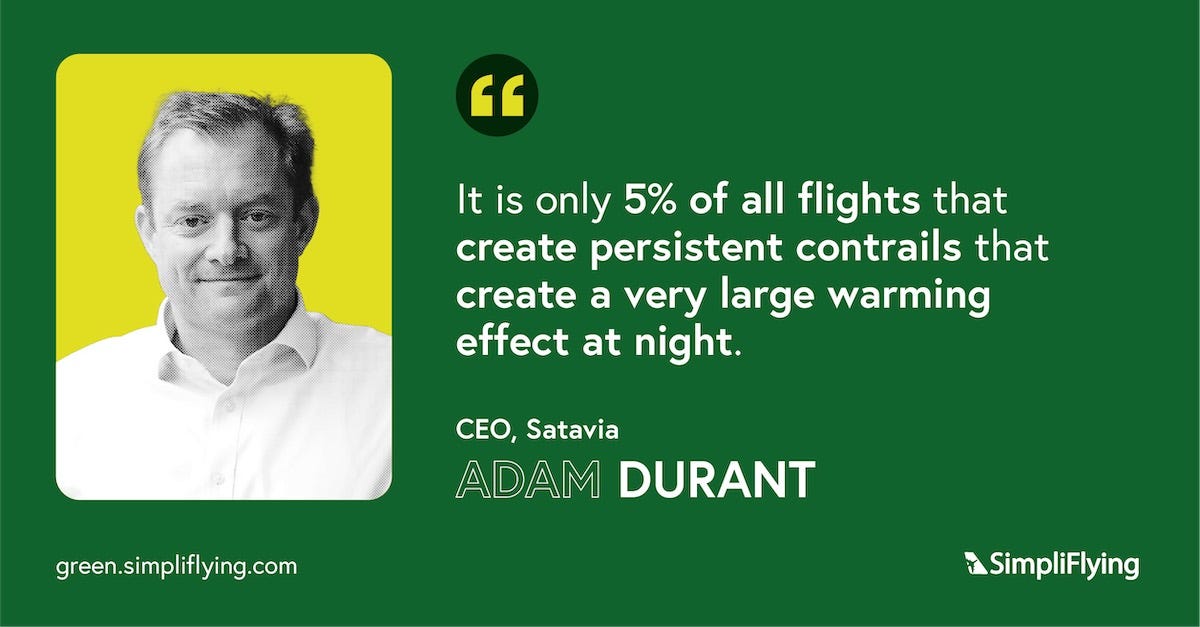In this episode of our ‘Sustainability in the Air’ podcast, Adam Durant, Founder & CEO of SATAVIA, speaks with SimpliFlying CEO Shashank Nigam about the groundbreaking work being done in the field of contrail reduction and its implications on the environment.
Durant started out as a volcanologist and transitioned into a career in aviation following the 2010 Icelandic volcano eruption that halted aviation. He collaborated with Airbus and easyJet to study volcanic ash. In 2013, he founded SATAVIA, a company initially aimed at protecting engines from harmful pollutants such as dust, ice, and volcanic ash, before shifting towards a more sustainability-oriented approach.
Here are the key highlights of the conversation:
Why it is important to look beyond carbon emissions (3:21)
How contrails form (5:56)
The science of the climate impact of contrails (9:21)
The SATAVIA story (12:24)
How does their prediction software work? (17:12)
SATAVIA’s gold standard verification (34:22)
How SATAVIA’s contrail prediction method is different (42:20)
Rapid Fire! (48:52)
Keep reading for a quick overview of the episode.
Why do contrails matter for sustainable aviation?
Did you know that the streaky clouds formed by planes are bad for the environment? Called contrails, these long, thin clouds often form behind an airplane in cold and humid conditions when water vapour freezes around small dust and soot particles from the engine. Although they look harmless, contrails are made up of small ice crystals that trap heat in the earth’s atmosphere and contribute to global warming.
Contrails have been observed since World War II, but their effect on the earth’s radiative balance is only now being addressed by the aviation industry. While the science and numbers behind contrails divides academics, there is general agreement that contrails are bad for the climate.
For example, one study found that contrails cause 57% of aviation’s warming impact. Another report by the IPCC in 2022 noted that contrails account for roughly 35% of the warming impact.
The good news? Durant says that only “persistent” contrails, formed by about 5% of flights, are at fault. He emphasises that not all contrails are harmful; some even have a cooling effect. He suggests a strategic approach, avoiding contrails that cause warming while possibly utilising those that have a cooling effect.
Durant stresses the importance of looking beyond carbon emissions to fully grasp and manage the aviation sector’s impact on climate change, highlighting that contrail management can be part of a broader strategy towards decarbonisation. For example, the EU is in the process of recognising the industry’s outsized climate impact by forming regulations.
5 ways Satavia is pushing for cleaner skies
1. Contrail prediction software
In 2018, SATAVIA began working on the problem of Ice Crystal Icing Conditions, which poses hazards to aviation, such as airspeed measurement errors and engine damage. This initiative received funding from the Aerospace Technology Institute in the UK and was supported by Rolls Royce, GKN Aerospace, and the University of Oxford. Over the years, the team validated and improved the microphysics of an American weather model and enhanced its ability to forecast high-level ice clouds.
By 2020 and 2021, they advanced the weather model, and in light of the IPCC report highlighting contrails as an environmental issue, shifted their focus to predicting conditions leading to persistent warming contrails.
The process of managing contrails is complex, depending on weather, geography, seasonality, and other factors. The team uses a supercomputer to run weather models, coupled with a model developed by the German Aerospace Centre. By analysing individual flight plans, they can target 5% of flights responsible for 80% of the warming effect and make necessary adjustments. This requires daily analyses, as both weather conditions and flight plans vary constantly.
They also retrospectively analyse the changes to understand the impact on climate:
“Critically, we go back about a week later, and we rerun our weather model in hindcast mode. We create what’s called a weather analysis product. This now is the best available weather data constrained by observations coming from satellites, ground-based measurements, and in situ measurements from radiosondes on balloons.
It’s a whole division of science called Data Assimilation that creates the datasets that are used to drive models and hindcast. We go back and look at the original flight plan, analyse both the CO2 and non-CO2 impacts, and look at the flown trajectory. We expect to see a reduction in overall climate impact, and we can express that in CO2 equivalent units. That is what we do for every flight.”
2. Pilot programmes with airlines
SATAVIA has been working with various airlines including Etihad, KLM and KLM Cityhopper to help them reduce contrail formation for their flights. They initially worked with Emirates through the Aviation X Lab, a Dubai-based incubator with backing from Airbus Towers, G Collins, and Emirates. This led to the first flight planning with Emirates, which in turn led to collaboration with Etihad for the first flights that managed contrails, using predictions from a specific weather model.
This collaboration also involved Boeing, GE, and others and was part of Etihad’s Greenliner and ecoDemonstrator programme. A 12-month proof of concept engagement with Etihad in 2022 involved weekly flight planning and analysis of their schedule, targeting flights producing long-lived warming contrails. Through this experience, they learned to optimise the process and understand its limitations.
Currently, they are beginning to engage more widely across the industry with backing from the European Space Agency, moving toward implementing this into day-to-day flight operations.
3. Creating contrail credits
A commercial motivation for contrail reduction is the creation of financial incentives for airlines.
In August 2023, SATAVIA announced that Gold Standard has approved their contrail management methodology concept, enabling future issuance of non-CO2 “Certified Mitigation Outcome Units (CMOUs).” Importantly, this decision recognises that contrails can affect the climate similarly to CO2 emissions. By understanding this link, a system of rewards or credits might be created. This would give airlines an incentive to manage these contrails, possibly reducing their negative effects on the climate.
“It’s incredibly difficult in a highly regulated industry to try and disrupt the way things are done without having a really strong financial incentive or regulation. So our approach – we have a patented method to create credits for the operators.
We’re trying to create an incentive, a carrot for airlines to do this, which comes at some cost, but we give them credits back ultimately, to cover the cost of doing that, and to incentivise them to do it. If we don’t take this approach, and we wait for regulation, which is coming in Europe, there will be financial penalties.”
4. SATAVIA vs Google AI
Durant acknowledges that different approaches are being developed to tackle the challenges associated with contrail formation. SATAVIA’s approach centres around numerical weather prediction modelling.
By focusing on accurate water vapour predictions, this method facilitates a deep connection with flight planning. This targeted analysis enables the identification of specific flights that create either warming or cooling contrails, effectively isolating a small fraction of flights that contribute to the majority of the warming problem from contrails.
Google’s approach, on the other hand, hinges on the analysis of satellite data. The methodology involves searching for linear cloud features in satellite imagery to identify contrail clouds and employing machine learning to both detect and forecast the movement of these clouds.
Whilst Google’s observational approach provides tangible benefits, it also presents a particular challenge, as Durant points out: the necessity to produce contrails in order to avoid them, meaning that complete avoidance is unattainable.
Durant argues that the two methods can complement each other. The synergy between pre-tactical decision-making, as facilitated by Durant’s approach, and the verification capability offered by Google’s method, once the aircraft are airborne, presents a holistic solution.
5. The future of contrail prediction
Durant has an interesting take when asked about the relevance of contrail management technology with the emergence of hydrogen-powered aircraft, specifically whether they will produce contrails and whether existing software can assist in avoiding them.
He recognises the potential of hydrogen as a means of decarbonising aviation. However, he emphasises that the combustion of hydrogen or its use in a fuel cell will still result in water emission. In fact, hydrogen propulsion could emit more water than kerosene, possibly leading to more widespread contrail clouds.
While this notion requires scientific verification, Durant insists that the methods being developed today could be equally relevant in the future:
“Regardless, we’re going to need contrail management in the future, even when we decarbonise and if we move to hydrogen. What we’re doing today could be equally applied to hydrogen aircraft of the future. And by that time, we should be even better at contrail management. So yes, it’s going to be a long-term solution that we need for aviation.”
‘Sustainability in the Air’ is the world’s leading podcast dedicated to sustainable aviation. Through in-depth conversations with top aviation leaders, we break through the clutter and provide a clear roadmap for a net-zero future.
This episode of the podcast is brought to you by Travelport, a global technology leader that powers bookings for travel suppliers worldwide. Their travel retailing marketplace, Travelport+, empowers travel retailers to understand and communicate the most sustainable travel options.














